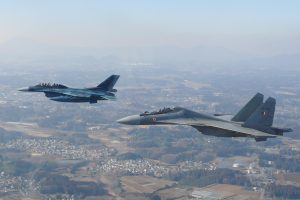From August to October 2022, the German Air Force conducted its first large-scale deployment in the Indo-Pacific region, known as Rapid Pacific. This was defense diplomacy by the German Air Force, symbolized by the “Air Ambassador” paint scheme on one of the six Eurofighters deployed to strengthen ties with allies and partners in the region, including Japan. Thus, Rapid Pacific marked the beginning of full-fledged airpower defense diplomacy in the region.
Defense diplomacy is the peacetime diplomatic activity of militaries aimed at maintaining and strengthening relations with allies and partners. Typically, navies are the primary actors in such efforts. However, ship-to-ship travel from Europe to the Indo-Pacific region typically takes weeks or months, whereas aircraft deployment takes only a matter of days. One of the key missions of Rapid Pacific was to demonstrate the deployment of fighter jets to Singapore in less than 24 hours. For this reason, airpower defense diplomacy is becoming increasingly active in this region.
Defense diplomacy by other countries’ air forces toward Japan has become more active. First, the Indian Air Force sent four Su-30MKI fighters to conduct Exercise Veer Guardian 2023 with the Japan Air Self-Defense Force (JASDF) at the Hyakuri Air Base near Tokyo in January. The French Air and Space Force also conducted Mission Pegase 2023, an unprecedentedly large-scale fighter deployment in the Indo-Pacific region, from June to August. In the first phase of the mission, 10 Rafale fighters, five tankers, and four cargo aircraft demonstrated a 30-hour deployment to Malaysia and Singapore. At the end of July, two Rafale fighters flew to Japan and conducted a joint exercise with the JASDF. In both the Indian and French cases, this was the first-time fighters flew to Japan.
In early August, the Italian Air Force sent four F-35A fighters and three tankers, two cargo aircraft, and one Conformal Airborne Early Warning to the Komatsu Air Base to conduct the first joint exercise with the JASDF in Japan. In October 2021, the JASDF agreed with the Italian Air Force to train its pilots at the Italian Air Force International Flight Training School. In December 2022, the Global Combat Air Program, a joint Japan-U.K.-Italy development program for next-generation fighter aircraft, was launched. In addition, the Italian Navy’s patrol ship Francesco Morosini called at Yokosuka in late June 2023, and in early July, Ryo Sakai, Chief of Staff of the Japan Maritime Self Defense Force (JMSDF), suggested the possibility of exchanging information with the Italian Navy, which already operates F-35B fighters on its aircraft carriers. The JMSDF also plans to upgrade the Izumo-class helicopter-carrying destroyer into a de facto aircraft carrier to operate F-35B fighters. Therefore, the JMSDF had much to learn from the Italian experience. Against these backgrounds, the joint exercise at the Komatsu Air Base suggests that such defense cooperation between Italy and Japan has entered a substantial stage.
At the Komatsu Air Base, a joint exercise Bushido Guardian 23 between the JASDF and the Royal Australian Air Force (RAAF) is also scheduled to take place from late August to mid-September. For Japan, Australia is a “quasi-ally” and an important security partner after the United States, and this is the second joint exercise between the Australian and Japanese air forces held in Japan. This time, 26 F-2, F-15, and F-35A fighters from the JASDF will participate in the exercise, while the RAAF is sending six F-35A fighters, three cargo aircraft, and tankers. For the JASDF, this will be an unprecedented scale of joint exercises with foreign partners in Japan.
The question is, why has the Komatsu Air Base been successively selected as a base for joint training? The first possible reason is that the Komatsu Air Base, facing the Sea of Japan, is the closest base to JASDF’s largest training airspace. A large training airspace is essential for the F-35A, a fifth-generation fighter aircraft, to demonstrate its capabilities fully. Second, the Sea of Japan has been a showcase for China and Russia’s military coordination. In the past few years, China and Russia have repeatedly held joint drills in the waters around Japan, and in July, they have held joint naval drills in the Sea of Japan.
Thus, it is natural to assume that the series of advanced joint exercises with allies and partners at the Komatsu Air Base is the message to check such actions by China and Russia. Simultaneously, it reminds us that Japan is a “frontline state” against China and Russia.

































